Chapter 2: Unopened Preflop Raise (UOPFR)
What is an unopened preflop raise?
Unopened Preflop Raise (UOPFR) tracks the percentage of hands in which a player raises preflop when the action folds to him. This allows you to understand a player's tendencies at a deeper level than the VPIP/PFR poker statistic does. VPIP/PFR gives you a general idea of the player type of your opponent. UOPFR gives you detailed information on the range of hands your opponent is playing from each position.
What is a hand range?
A hand range is the possible hand combinations with which a player opens from each position. Understanding your opponent's range of hands from each position is key to developing your preflop cold-calling range, your blind defense ranges, and your 3-bet ranges, all of which will be discussed later. This guide introduces you to preflop hand ranges and calling raises in position. This knowledge is the foundation of your poker strategy and is essential to thinking about the game at a deeper level.
The images included in this poker guide are taken from a free program called Equilab. Most online poker sites do not allow you to run Equilab while playing, as it gives you an advantage they deem unfair. However, it is a useful tool for study and review.
What is a good UOPFR for beginners from each position?
Playing winning poker starts with raising the correct range of hands from each position. These images show beginner hand ranges for six-max tables. For full ring tables, the first positions must play even tighter.
As a beginner, we recommend that you never open limp. "Open limping" means that instead of raising as the first player into the pot, you merely call the big blind. But it is almost always better to raise preflop. It makes your decisions and actions much clearer both preflop and postflop.
You need to start with a selective range of hands. These hands are picked to flop strong holdings and powerful draws to make your postflop decisions easier and more profitable. As you grow stronger in your poker strategy, you will be able to widen these ranges by roughly 20%.
How to use Equilab hand charts
Each image below shows the percentage of hands that you can open with profitably according to your position. These hands are marked in blue. Consider keeping this guide open as you play, and refer to it for each position until you are familiar with the hand ranges.
Under the gun (UTG) – 12%
The first position is “under the gun,” which is three seats before the dealer button. This position is first to act preflop. Because you have so many players acting after you, and you are forced to play pots out of position when any player other than the blinds calls, you need to have a range advantage against your opponents. You win money from this position by playing strong hands.

Middle position (MP) – 14%
Middle position, which can also be called the “hijack” (HG), is two seats before the dealer button. You are opening almost as tight as UTG for the same reasons of positional disadvantage. You win money from this position primarily by playing strong hands.
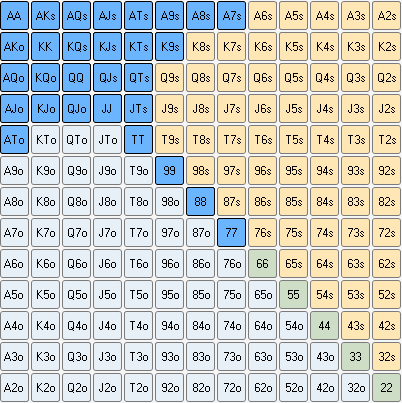
Cut-off (CO) – 24%
The “cut-off” is the seat right before the button. This position is where you start playing a wider range of hands. You win money in this position not only by playing strong hands, but also by picking up the blinds preflop. You have positional advantage against all players except the button. This position will win you the second most money of all the positions over the long term.
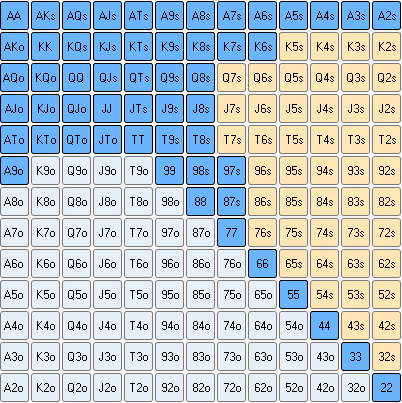
Button (BTN) – 45%
The button is the best seat in the house. This position has postflop advantage against all players, as it is seated to the right of the blinds and is therefore the last to act. You win most of your money by stealing blinds and by playing in position against the blinds. Winning players can open as much as 65% from the button against certain opponents, but beginners should start with a tighter range.
The button is where you can “steal the blinds,” a concept that is explained in depth in the blind stealing section of our poker statistics guide.
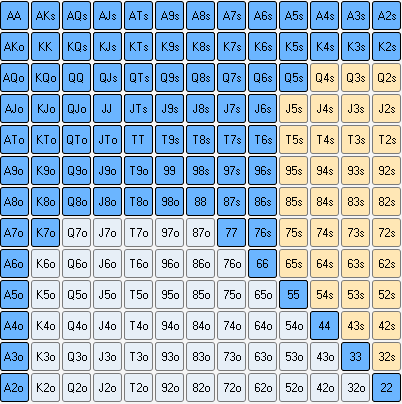
What about the small and big blinds?
Defending and raising from the blinds is dependent on the players at your table. Using a hand chart for this would be doing a disservice to your long-term strategy. For more information on the blinds, please consult our guide to blind stealing.
When can you widen your UOPFR range?
If you are a new player, or a recreational player who is breaking even or losing at the low stakes, we recommend that you start with these hand ranges for at least 1,000 to 10,000 hands. After 1,000 hands and using our guide to identifying player types using VPIP/PFR, you should be skilled enough to start widening these ranges by roughly 20% when you notice weaker players at the table. For example, if you have a very tight player in the big blind who is folding to 75% of button raises, you can start widening your range considerably.
The main reason for widening your range is that you have a skill advantage on your opponents and no longer require as much of a range advantage.
If you are at a passive table where players are calling too much, the value of pocket pairs goes up dramatically. At a table like this, even 22 can be an open from the first position, because if you do hit your set and players are calling too much, then you can win a massive pot. This is using a concept called “implied odds,” which we explain further below.
Flat calling using UOPFR
A flat call occurs when one player raises and a player in a later position then calls behind. For example, the UTG player raises preflop and the BTN player calls in position.
Unless you are in the big or small blinds, you will have positional advantage over your opponent. But you will also have the disadvantage of having a range of hands that does not include your strongest holdings, because with those you will be 3-betting (that is, re-raising the initial raise) for value.
You flat call a hand because it is ahead of their opening range, but behind the range of hands that they will call against a 3-bet. Let’s go through an example hand.
Your opponent has an UOPFR of 10% UTG, and a "fold to 3-bet" of 50%. You are in MP with JJ facing an UTG raise. Here is a visual representation of a 10% range. Use this to narrow your opponent down to a range of hands.
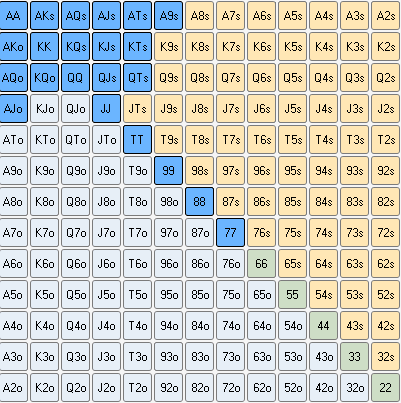
Now, let's use a second feature of Equilab. This feature analyzes how a specific hand is doing against a range of hands. PokerStove runs simulations of hundreds of thousands of hands in order to calculate the percentage of times that one hand beats a range of hands in an all-in situation. This percentage is known as “equity.”

As you can see, JJ is a favorite against your opponent. This hand has great equity against their range. It is a clear call.
However, what happens if you 3-bet? Since your opponent is calling only 50% of the time, his 3-bet calling range is now roughly 5% of hands. Let’s get a visual representation of this range.
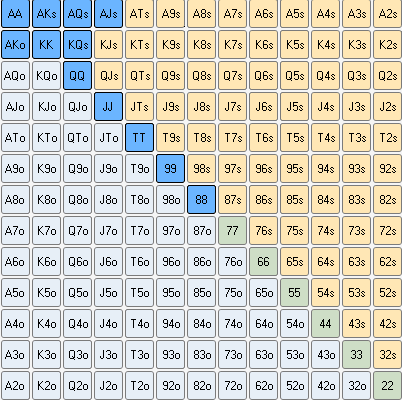
How is our JJ faring against this range?

Our JJ as a 3-bet is a slight underdog against our opponent. Even worse, they may 4-bet (re-raising the 3-bet) with hands such as AQ or AK that we have good equity against. If we are folding to a 4-bet, then we lose value when our opponent decides to 4-bet with AK and AQ. But if we call the 4-bet, we are now playing a massive pot against hands that include QQ, KK, and AA. Most players are not bluffing very often when they 4-bet, especially at the low stakes. This makes JJ very difficult to navigate against a 4-bet. Flat calling versus such a tight range is generally the better play.
Flat calling with implied odds
“Implied odds” means the money you expect to win when you hit your hand. A pocket pair hits a set on the flop roughly 12% of the time. That means that if you are against a very tight player and you call an open that is 2.5 times the big blind (2.5bb) with a hand like 77, you can win a huge pot when you hit your set because you are against a tight range of hands.
A set occurs when you have a hand like 77 and the flop comes AK7. As you can see, if your opponent has a range that is tight and therefore weighted towards hands like AQ, AK, AJ, or KQ, they are going to lose a very big pot against you on this sort of board when they hit the flop. Implied odds rely on the stack size of your opponent. If your opponent has a standard 100bb stack and calls too much postflop, hands like pocket pairs go up in value because you can win a very large pot when you hit your hand. If your opponent only has a 20bb stack, your implied odds are much lower. You only hit your set 12% of the time, and when you do you can only win up to 20bb.
Active players to your left reduce your implied odds
If you have active 3-betters to your left or players who like to squeeze (that is, who is like to make a large raise after there has already been a raise and a call), your implied odds of calling preflop is lowered. This is because you will often face a squeeze bet which forces you out of the pot, stopping you from realizing your equity against the original raiser. Tighten up both your UOPFR range and flat calling range when you have a strong, active player to your left! For more information on this, please read Chapter 8: Squeeze Bets.
The ideal situation for calling hands like suited aces and low pocket pairs that have good implied odds is to be at a very passive table. Flat calling with hands with implied odds is an intermediate play that should be done only when you have a strong understanding of the game.